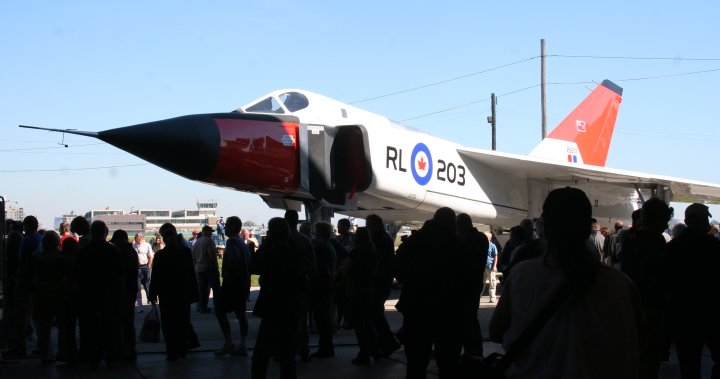Hi mtime7! Great article! Thanks.
55 years later, biggest question surrounding Avro Arrow remains “what if?” - National | Globalnews.ca
For many Canadians, the Avro Arrow has come to symbolize both the potential, and the unfulfilled promise, of Canadian innovation.globalnews.ca
forget the phony claims in the video above, although they are funny..
55 years later, biggest question surrounding Avro Arrow remains “what if?”
View attachment 15929
Fifty-five years ago today, on March 25, 1958, the infamous Avro Arrow made its very first test flight.
The plane was the crown jewel of Canadian aircraft manufacturer A.V. Roe Canada, better known as Avro, then the third-largest company in Canada. The hypersonic fighter was on the cutting edge of aerospace technology at the time: it could reach a speed nearly three times the speed of sound, travelling at an altitude of 60,000 feet.
The first flight of the Arrow should have been a crowning moment for the Canadian aerospace industry. Yet the plane was scrapped by the federal government just a few months later, in a decision that remains controversial to this day.
For many Canadians, the Avro Arrow has come to symbolize both the potential, and the unfulfilled promise, of Canadian innovation.
“The Arrow represents a period when Canada stood up on its own and did its own thing,” Paul Squires, a historian with the Canadian Aeronautical Preservation Association, told Global News. “In many ways, it’s become a symbol of the country.”
“At the time, we were in the top three of the largest producers of aeronautical parts in the world. But the cancellation of the Arrow absolutely devastated the Canadian aerospace industry.”
When it comes to the Avro Arrow, the true regret is what might have been: Flying saucers. Hover cars. A Lunar rover – and even the possibility of a Canadian using it.
The fall of the Avro Arrow
So why was the Avro Arrow cancelled by the Canadian government in 1959?
“The official reason given by the Diefenbaker government [at that time] was that the Arrow was too expensive, and it was no longer worth the money,” Cohen said. “Avro as a company was going through millions of taxpayer dollars.”
“The government had an agenda to destroy it. They wanted the money for other things, so they came up with all kinds of reasons why they didn’t need it,” Squires said.
The reasons for the cancellation of the Arrow were a mix of politics, timing, and bad luck. The CF-105 (as the Arrow was officially known) was originally designed as a long-range interceptor, meant to meet and destroy Soviet bombers.
But on October 4, 1957 – the same day as the first Avro Arrow rolled off the production line – the Soviets launched the satellite Sputnik, becoming the first nation to put a man-made object into orbit.
And just like that, everything changed.
“It really was a case of the worst timing,” Squires said. “The same day as Avro rolls out their aircraft, you had millions of people around the world looking up at the stars, trying to look for Sputnik.”
That development changed the focus for militaries on both sides of the Cold War, away from conventional bombers and towards atmospheric weapons like intercontinental ballistic missiles.
Then there was the often-contentious relationship between conservative Prime Minister John Diefenbaker, and Avro Canada president Crawford Gordon, Jr.
“Diefenbaker didn’t drink, didn’t smoke, he was a complete teetotaler,” Squires said. “And in walks Crawford Gordon with his hip flask, a cigarette in his hand, pounding on Diefenbaker’s desk. They were complete polar opposites.”
There was also the changing politics surrounding the creation of the North American Aerospace Defense Command, or NORAD. One of the specifics of this deal was the purchase by the U.S. Air Force of the new Avro Arrow fighter.
“When we were negotiating NORAD under the St. Laurent government, the U.S. would send a note, and the government would haggle over specifics and send one back,” Squires explained. “Well Mr. St. Laurent lost [the 1957 election], Mr. Diefenbaker came in, and the newest U.S. paper now says they no longer wish to purchase the Arrow.”
“Diefenbaker just looked at it, said ‘looks good’ and signed it. Even Americans were shocked, because they expected some pushback.”
The cancellation of the CF-105 Arrow was a deathblow for Avro. It was also a serious setback for the Canadian aerospace industry as a whole.
“Fifteen thousand people lost their jobs at Avro [as a result of the Arrow’s cancellation], but many more people outside of the company lost their jobs too,” Cohen said. “People in the supply chain, parts manufacturers, the support network. Within six months, thousands more were out of work.”
You are using an out of date browser. It may not display this or other websites correctly.
You should upgrade or use an alternative browser.
You should upgrade or use an alternative browser.
Canada's F18 replacement news & updates
- Thread starter Khafee
- Start date
I think name was Malton Airport not Pearson those days??Hi mtime7! Great article! Thanks.
Bingo! Give that man a cupie doll! Yes, Mingle you are absolutely correct. It was named Walton International Airport and then was changed later to Lester B. Pearson International Airport in honour of our Prime Minister.I think name was Malton Airport not Pearson those days??
I met Korean war vet Colonel Curtis a F86 canadier pilot he told me engine facility at Malton airport for Canadier F86 he was great admirer for PAF pilots used to call them Hot guys Hot pilotsBingo! Give that man a cupie doll! Yes, Mingle you are absolutely correct. It was named Walton International Airport and then was changed later to Lester B. Pearson International Airport in honour of our Prime Minister.
Last edited:
